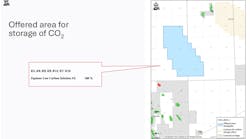Model building and depth conversion
Cubit, from Scott Pickford, was shown at AAPG this year. The system provides seismic interpreters with previously unavailable but essential links between profile-based seismic interpretation workstations and mapping packages. It utilizes the entire interpretation picked on seismic workstations to produce continual surfaces by combining both fault and event data. The resulting surfaces can be depth converted to generate structural models for mapping and basin analysis. Cubit also is used as a pre-processor for section balancing, volume modeling, and non-vertical depth conversion.
Selected AAPG papers:
- Calibrating pore pressure plots in the Gulf of Mexico's Tertiary clastic basins where geopressure is caused by aquathermal pressuring was the subject of Unocal's Joel Alnes' and Tony Lilburn's paper. It is achieved by graphing temperature-adjusted minimum shale resistivities with the ratio of actual to predicted pore pressures for a group of wells in a given area. Low salinity waters cause pore pressure estimates to be low, while high salinity cause them to be high.
- The application of high resolution sequence stratigraphy to fluvial reservoir analysis is discussed in a paper by Hongwen Deng and Hongliang Wang of China University of Geosciences in Beijing. The stratigraphic framework of the upper member of the Guantao Formation in the offshore Jiyang Depression, Bohai Bay is established and facies distribution predicted via four intermediate-scale stratigraphic cycles that are identified using detailed analysis from well logs and cores. Seismic sequence stratigraphy analysis is achieved by converting stratigraphic interpretations from the well logs into seismic reflection geometry and waveform character based on seismogram synthesis.
- An interesting analog of the Eastern Gulf of Mexico for deepwater exploration in Angola's Lower Congo Basin was developed in a paper by Ian J. Stewart of British Petroleum, Uxbridge, UK. It maintains that both in structural development and the formation of an intra-slope depositional topography, the Eastern Gulf is analogous. Stratigraphy of the Lower Congo Basin indicates Oligocene through to Pliocene slope depositional sequences, overlying Late Cretaceous age carbonate and clastic sediments above Early Cretaceous age salt, which has evacuated to form complex diapirs and canopy geometries that have marketedly affected the dispersal of the Tertiary slope reservoir systems.
- Life on Mars was suggested as proven in a paper presented by Everett K. Gibson and his colleagues at NASA Houston, Stanford, McGill, and Georgia Universities. Their paper, a popular presentation, showed that a meteorite found on Earth but originating on Mars had occurrence of microscopic forms that resemble terrestrial bacteria and microfossils, microscopic mineral grains with a composition and crystal form that on earth is associated with biogenic activity, and reduced carbon in the form of polycyclic aromatic hydrocarbons associated with decomposition of bacteria. Each alone have alternative, non-biotic explanations, but together suggest the past existence of life on Mars.
- Scores of other outstanding geological and geophysical papers were presented. Several more will be outlined in next month's column.
New CARM technology
Landmark Graphics unveiled its new computer-aided reservoir management technology at this year's American Association of Petroleum Geologists' annual meeting in Dallas, April 6th. The CARM system is a family of more than 15 integrated reservoir management solutions that provide essential tools for the life of a reservoir, from discovery through depletion and finally abandonment.
The new solution helps geoscientists better characterize large and small reservoirs quickly, aids multidisciplinary asset teams in simulating the movement of formation liquids and estimating recoverable reserves, as well as in managing wells efficiently.
PC desktop interpretation
GeoGraphix has recently released its SeisVision 3.0, a 2D/3D seismic interpretation and mapping system for the PC desktop. The system adds fully integrated 2D seismic interpretation functionality to the previous edition of SeisVision's 3D interpretation features. Operating in Microsoft Windows, it is easily learned yet capable of handling complex problems.
This new edition of SeisVision allows users to create high quality displays of 2D and 3D seismic data. Inlines, crosslines, arbitrary and composite vertical seismic lines can all be simultaneously displayed. Furthermore, users can flatten seismic displays to a picked horizon, facilitating interpretation, and can readily select either horizon or fault.
Copyright 1997 Oil & Gas Journal. All Rights Reserved.


